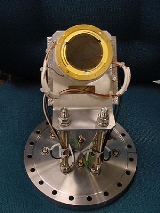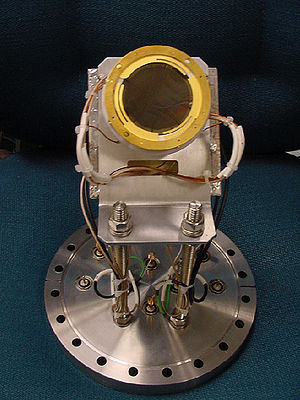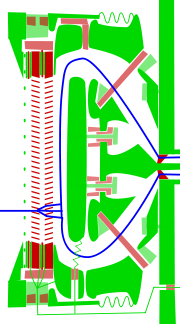
Microchannel plate detector
Encyclopedia

Electron
The electron is a subatomic particle with a negative elementary electric charge. It has no known components or substructure; in other words, it is generally thought to be an elementary particle. An electron has a mass that is approximately 1/1836 that of the proton...
s or ion
Ion
An ion is an atom or molecule in which the total number of electrons is not equal to the total number of protons, giving it a net positive or negative electrical charge. The name was given by physicist Michael Faraday for the substances that allow a current to pass between electrodes in a...
s) and impinging radiation
Radiation
In physics, radiation is a process in which energetic particles or energetic waves travel through a medium or space. There are two distinct types of radiation; ionizing and non-ionizing...
(ultraviolet
Ultraviolet
Ultraviolet light is electromagnetic radiation with a wavelength shorter than that of visible light, but longer than X-rays, in the range 10 nm to 400 nm, and energies from 3 eV to 124 eV...
radiation and X-rays). It is closely related to an electron multiplier
Electron multiplier
An electron multiplier is a vacuum-tube structure that multiplies incident charges. In a process called secondary emission, a single electron can, when bombarded on secondary emissive material, induce emission of roughly 1 to 3 electrons...
, as both intensify single particles or photons by the multiplication of electron
Electron
The electron is a subatomic particle with a negative elementary electric charge. It has no known components or substructure; in other words, it is generally thought to be an elementary particle. An electron has a mass that is approximately 1/1836 that of the proton...
s via secondary emission
Secondary emission
Secondary emission in physics is a phenomenon where primary incident particles of sufficient energy, when hitting a surface or passing through some material, induce the emission of secondary particles. The primary particles are often charged particles like electrons or ions. If the secondary...
. However, because a microchannel plate detector has many separate channels, it can additionally provide spatial resolution.
Basic design
A micro-channel plate is a slab made from highly resistiveElectrical resistance
The electrical resistance of an electrical element is the opposition to the passage of an electric current through that element; the inverse quantity is electrical conductance, the ease at which an electric current passes. Electrical resistance shares some conceptual parallels with the mechanical...
material of typically 2 mm thickness with a regular array of tiny tubes or slots (microchannels) leading from one face to the opposite, densely distributed over the whole surface. The microchannels are typically approximately 10 micrometer
Micrometre
A micrometer , is by definition 1×10-6 of a meter .In plain English, it means one-millionth of a meter . Its unit symbol in the International System of Units is μm...
s in diameter (6 micrometer in high resolution MCPs) and spaced apart by approximately 15 micrometers; they are parallel to each other and often enter the plate at a small angle to the surface (~8° from normal).
Operating mode
Each microchannel is a continuous-dynode electron multiplierElectron multiplier
An electron multiplier is a vacuum-tube structure that multiplies incident charges. In a process called secondary emission, a single electron can, when bombarded on secondary emissive material, induce emission of roughly 1 to 3 electrons...
, in which the multiplication takes place under the presence of a strong electric field. A particle or photon that enters one of the channels through a small orifice is guaranteed to hit the wall of the channel due to the channel being at an angle to the plate and thus the angle of impact. The impact starts a cascade of electrons that propagates through the channel, which amplifies the original signal by several orders of magnitude depending on the electric field strength and the geometry of the micro-channel plate. After the cascade, the microchannel takes time to recover (or recharge) before it can detect another signal.
The electrons exit the channels on the opposite side where they are themselves detected by additional means, often simply a single metal anode measuring total current. In some applications each channel is monitored independently to produce an image. Phosphors in combination with photomultiplier
Photomultiplier
Photomultiplier tubes , members of the class of vacuum tubes, and more specifically phototubes, are extremely sensitive detectors of light in the ultraviolet, visible, and near-infrared ranges of the electromagnetic spectrum...
tubes have also been used.
Chevron MCP

Z stack MCP
This is an assembly of three microchannel plates with channels aligned in a Z shape. Single MCPs can have gain up to 10,000 but this system can provide gain more than 10 million.The detector

Volt
The volt is the SI derived unit for electric potential, electric potential difference, and electromotive force. The volt is named in honor of the Italian physicist Alessandro Volta , who invented the voltaic pile, possibly the first chemical battery.- Definition :A single volt is defined as the...
s to the acceleration optics (for electron detection), each MCP, the gap between the MCPs, and the backside of the last MCP and the collector (anode
Anode
An anode is an electrode through which electric current flows into a polarized electrical device. Mnemonic: ACID ....
). The last voltage dictates the time of flight of the electrons and in this way the pulse-width
Pulse-width modulation
Pulse-width modulation , or pulse-duration modulation , is a commonly used technique for controlling power to inertial electrical devices, made practical by modern electronic power switches....
. The anode is a 0.4 mm thick plate with an edge of 0.2 mm radius to avoid high field strengths. It is just large enough to cover the active area of the MCP, because the backside of the last MCP and the anode act as a capacitor
Capacitor
A capacitor is a passive two-terminal electrical component used to store energy in an electric field. The forms of practical capacitors vary widely, but all contain at least two electrical conductors separated by a dielectric ; for example, one common construction consists of metal foils separated...
with 2 mm separation and large capacitance
Capacitance
In electromagnetism and electronics, capacitance is the ability of a capacitor to store energy in an electric field. Capacitance is also a measure of the amount of electric potential energy stored for a given electric potential. A common form of energy storage device is a parallel-plate capacitor...
slows down the signal. The positive charge in the MCP influence
Influence
Influence may refer to:In science and technology:*Sphere of influence , the region around a celestial body in which it is the primary gravitational influence on orbiting objects...
s positive charge in the backside metalization. A hollow torus
Torus
In geometry, a torus is a surface of revolution generated by revolving a circle in three dimensional space about an axis coplanar with the circle...
conducts this around the edge of the anode plate. A torus is the optimum compromise between low capacitance and short path and for similar reasons usually no dielectric (Markor) is placed into this region. After a 90° turn of the torus it is possible to attach a large coaxial waveguide
Coaxial cable
Coaxial cable, or coax, has an inner conductor surrounded by a flexible, tubular insulating layer, surrounded by a tubular conducting shield. The term coaxial comes from the inner conductor and the outer shield sharing the same geometric axis...
. A taper permits minimizing the radius so that an SMA connector can be used. To save space and make the impedance match less critical, the taper is often reduced to a small 45° cone on the backside of the anode plate.
The typical 500 volts between the backside of the last MCP and the anode cannot be fed into the preamplifier. Therefore the inner or the outer conductor needs a DC-block, that is, a capacitor. Often it is chosen to only have 10-fold capacitance compared to the MCP-anode capacitance and is implemented as a plate capacitor. Rounded, electro-polished metal plates and the ultra high vacuum allow very high field strengths and high capacitance without a dielectric. The bias for the center conductor is applied via resistors hanging through the waveguide (see bias tee
Bias tee
A bias tee is a three port network used for setting the DC bias point of some electronic components without disturbing other components. The bias tee is a diplexer. The low frequency port is used to set the bias; the high frequency port passes the radio frequency signals but blocks the biasing...
). If the DC block is used in the outer conductor, it is in parallel with the larger capacitor in the power supply. Assuming good screening, the only noise is due to current noise from the linear power regulator. Because the current is low in this application and space for large capacitors is available, and because the DC-block capacitor is fast, it is possible to have very low voltage noise, so that even weak MCP signals can be detected. Sometimes the preamplifier is on a potential (off ground) and gets its power through a low-power isolation transformer
Transformer
A transformer is a device that transfers electrical energy from one circuit to another through inductively coupled conductors—the transformer's coils. A varying current in the first or primary winding creates a varying magnetic flux in the transformer's core and thus a varying magnetic field...
and outputs its signal optically
Opto-isolator
In electronics, an opto-isolator, also called an optocoupler, photocoupler, or optical isolator, is "an electronic device designed to transfer electrical signals by utilizing light waves to provide coupling with electrical isolation between its input and output"...
.


Jitter
Jitter is the undesired deviation from true periodicity of an assumed periodic signal in electronics and telecommunications, often in relation to a reference clock source. Jitter may be observed in characteristics such as the frequency of successive pulses, the signal amplitude, or phase of...
leading edge is sent to the time to digital converter
Time to digital converter
In electronic instrumentation and signal processing, a time to digital converter is a device for converting a signal of sporadic pulses into a digital representation of their time indices. In other words, a TDC outputs the time of arrival for each incoming pulse...
. The jitter can be further reduced by means of a constant fraction discriminator
Constant fraction discriminator
A constant fraction discriminator is an electronic signal processing device, designed to mimic the mathematical operation of finding a maximum of a pulse by finding the zero of its slope....
. That means that MCP and the preamplifier are used in the linear region (space charge negligible) and the pulse shape is assumed to be due to an impulse response
Impulse response
In signal processing, the impulse response, or impulse response function , of a dynamic system is its output when presented with a brief input signal, called an impulse. More generally, an impulse response refers to the reaction of any dynamic system in response to some external change...
with variable height but fixed shape from a single particle.
Because MCPs have a fixed charge that they can amplify in their life, especially the second MCP has a lifetime problem. It is important to use thin MCPs, low voltage and instead more sensitive and fast semiconductor amplifiers after the anode. (see: Secondary emission#Special amplifying tubes, http://www.physics.utah.edu/~sommers/hybrid/correspondence/gemmeke.y98m11d09, http://cos-arl.colorado.edu/Documents/COS-11-0012.pdf,
.).
With high count rates or slow detectors (MCPs with phosphor
Phosphor
A phosphor, most generally, is a substance that exhibits the phenomenon of luminescence. Somewhat confusingly, this includes both phosphorescent materials, which show a slow decay in brightness , and fluorescent materials, where the emission decay takes place over tens of nanoseconds...
screen or discrete photomultiplier
Photomultiplier
Photomultiplier tubes , members of the class of vacuum tubes, and more specifically phototubes, are extremely sensitive detectors of light in the ultraviolet, visible, and near-infrared ranges of the electromagnetic spectrum...
s) pulses overlap. In this case a high impedance (slow, but less noisy) amplifier and an ADC
Analog-to-digital converter
An analog-to-digital converter is a device that converts a continuous quantity to a discrete time digital representation. An ADC may also provide an isolated measurement...
is used. Since the output signal from the MCP is generally small, the presence of the thermal noise limits the measurement of the time structure of MCP signal. However with the fast amplification schemes, is possible to have valuable information on the signal amplitude, even at very low signal values. But yet, not successful on the time structure information of the wideband
Wideband
In communications, wideband is a relative term used to describe a wide range of frequencies in a spectrum. A system is typically described as wideband if the message bandwidth significantly exceeds the channel's coherence bandwidth....
signals.
Delay line detector
In a delay line detector the electrons are accelerated to 500 eV between the back of the last MCP and a grid. Then they fly for 5 mm and are dispersed over an area of 2 mm. A grid follows. Each element has a diameter of 1 mm and consists of an electrostatic lens focusing arriving electrons through a 30 µm hole of a grounded sheet of aluminium. Behind that a cylinder of the same size follows. The electron cloud induces a 300 ps negative pulse when entering the cylinder and a positive when leaving. After that another sheet, a second cylinder follows, and a last sheet follows. Effectively the cylinders are fused into the center-conductor of a striplineStripline
Stripline is a transverse electromagnetic transmission line medium, that was invented by Robert M. Barrett of the Air Force Cambridge Research Centre in the 1950s.- Description :...
. The sheets minimize cross talk between the layers and adjacent lines in the same layer, which would lead to signal dispersion
Dispersion (optics)
In optics, dispersion is the phenomenon in which the phase velocity of a wave depends on its frequency, or alternatively when the group velocity depends on the frequency.Media having such a property are termed dispersive media...
and ringing. These striplines meander across the anode to connect all cylinders, to offer each cylinder 50 Ω impedance, and to generate a position dependent delay. Because the turns in the stripline adversely affect the signal quality their number is limited and for higher resolutions multiple independent striplines are needed. At both ends the meanders are connected to detector electronics. These electronics convert the measured delays into X- (first layer) and Y-coordinates (second layer). Sometimes a hexagonal grid and 3 coordinates are used. This redundancy reduces the dead space-time by reducing the maximum travel distance and thus the maximum delay, allowing for faster measurements. The microchannel plate detector must not operate over around 60 degree Celcius, otherwise it will degrade rapidly, bakeout without voltage has no influence.
Examples of use
- A 1 GHz real-time display CRT for an analog oscilloscope (the Tektronix 7104) used a microchannel plate placed behind the phosphor screen to intensify the image. Without the plate, the image would be excessively dim, because of the electron-optical design.
- MCP detectors are often employed in instrumentation for physical research, and they can be found in devices such as electronElectron spectrometerIn an Electron spectrometer, an incoming beam of electrons is bent with electric or magnetic fields. As higher energy electrons will be bent less by the beam, this produces a spatially distributed range of energies....
and mass spectrometers.
See also
- Particle detectorParticle detectorIn experimental and applied particle physics, nuclear physics, and nuclear engineering, a particle detector, also known as a radiation detector, is a device used to detect, track, and/or identify high-energy particles, such as those produced by nuclear decay, cosmic radiation, or reactions in a...
- PhotodetectorPhotodetectorPhotosensors or photodetectors are sensors of light or other electromagnetic energy. There are several varieties:*Active pixel sensors are image sensors consisting of an integrated circuit that contains an array of pixel sensors, each pixel containing a both a light sensor and an active amplifier...
- Night vision device
- Image intensifierImage intensifierAn image intensifier tube is a vacuum tube device for increasing the intensity of available light in an optical system to allow use under low light conditions such as at night, to facilitate visual imaging of low-light processes such as fluorescence of materials to X-rays or gamma rays, or for...
- Nanochannel glass materialsNanochannel glass materialsNanochannel glass materials are an experimental mask technology that is an alternate method for fabricating nanostructures, although optical lithography is the predominant patterning technique....

